Guidelines for Rolling in Cricket - Ecb - England and Wales Cricket ...
Guidelines for Rolling in Cricket - Ecb - England and Wales Cricket ...
Guidelines for Rolling in Cricket - Ecb - England and Wales Cricket ...
Create successful ePaper yourself
Turn your PDF publications into a flip-book with our unique Google optimized e-Paper software.
Centre <strong>for</strong> Sports Surface Technology<br />
3 GUIDELINES FOR CHOOSING THE RIGHT ROLLER FOR<br />
YOUR CLUB<br />
There are many th<strong>in</strong>gs to consider when choos<strong>in</strong>g a roller <strong>for</strong> your club but it is usually<br />
cost that is the over-rid<strong>in</strong>g concern, whether it is an outright purchase by the club or part<br />
of an ECB funded scheme. But it's not simply a case of buy<strong>in</strong>g the biggest roller you can<br />
af<strong>for</strong>d. The discussions above have shown that by match<strong>in</strong>g roller specification to the<br />
club's pitches <strong>and</strong> other resources, it is possible to buy an effective roller <strong>and</strong> save money<br />
or to improve pitch preparation by purchas<strong>in</strong>g the right kit.<br />
What is essential is that roller selection is based on:<br />
1. Soil type.<br />
2. Whether or not covers are available.<br />
3. The thatch management strategy.<br />
The first two factors, soils <strong>and</strong> covers relate to optimum moisture content. If there are<br />
high clay content soils <strong>and</strong>/or high organic matter <strong>and</strong> no covers then there is little po<strong>in</strong>t<br />
<strong>in</strong> gett<strong>in</strong>g a top of the range heavy 2.2t roller (<strong>and</strong> certa<strong>in</strong>ly not a 3t road roller) – it will<br />
be a struggle to get pitches dry enough <strong>for</strong> the roller to achieve its compaction potential.<br />
Consider purchas<strong>in</strong>g a set of roll-on covers or if cover deployment is not possible <strong>for</strong><br />
reasons of security etc then you might consider gett<strong>in</strong>g a 1-1.5 tonne roller which will<br />
have a compactive potential matched to the soil moisture conditions. This would save<br />
money. If there are different loams <strong>in</strong> the square then select a roller <strong>for</strong> the higher clay<br />
content loams – provid<strong>in</strong>g there are the covers to manage them.<br />
As <strong>for</strong> the third factor then it is all about how successful thatch management is. If there is<br />
a thatch accumulation <strong>in</strong> the pitches <strong>and</strong> the specialist equipment <strong>for</strong> effective thatch<br />
reduction/control is not available then consider purchas<strong>in</strong>g this as a priority – aga<strong>in</strong> it is<br />
po<strong>in</strong>tless purchas<strong>in</strong>g a heavy roller without good thatch control. An alternative<br />
would be to consider hir<strong>in</strong>g a 1-1.5 tonne roller <strong>and</strong> <strong>in</strong>vest<strong>in</strong>g the difference on thatch<br />
control equipment or removal/replacement of thatch surfaces. It is always possible to<br />
trade up to a heavier roller when thatch is under control. But while there is thatch, thatch<br />
will be the limit<strong>in</strong>g per<strong>for</strong>mance factor, not the roller.<br />
Page 30 of 34<br />
www.cranfield.ac.uk/sas/sst<br />
© Cranfield University, 2009


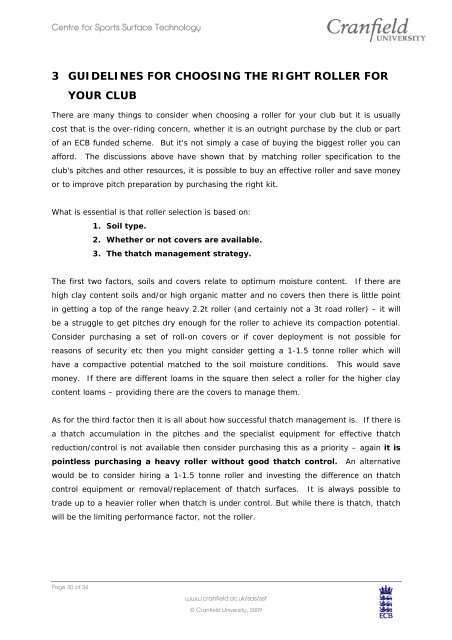
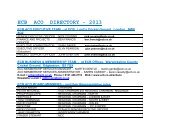
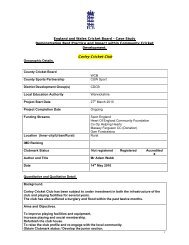


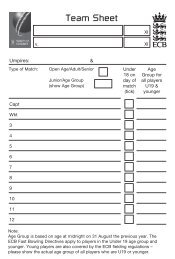
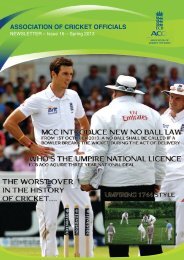
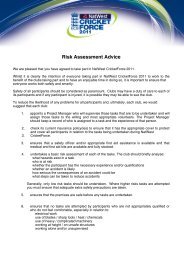
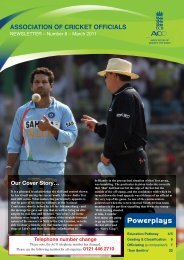


![Indoor Sports Halls with Cricket Provision [TS3] - Ecb - England and ...](https://img.yumpu.com/49070696/1/190x135/indoor-sports-halls-with-cricket-provision-ts3-ecb-england-and-.jpg?quality=85)



